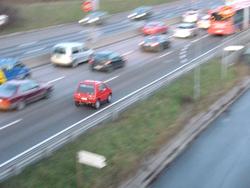 |
| Using 7 TWh, which is just 5 percent of Norway’s total electric power production, all light vehicles in Norway can be powered by electricity. Photo: Are Wormnes |
The Norwegian government and the European Union (EU) have drawn up regulations aimed at reducing fossil CO2 emissions from road traffic. This is a challenge that has to be met through a spectrum of measures. One focus is on the possibilities and constraints connected with “Electricity for cars”, technology by which cars can be charged through power grids and Norwegian hydroelectric power.
High number of electric vehicles
Norway is one of the countries in the world with the highest number of electric vehicles per inhabitant (vehicles using electric power stored I batteries) and with economic policies strongly stimulating purchase, import, production and development of such vehicles.
Plug-in hybrid vehicles will operate on energy stored in batteries and with more conventional energy carrier. Plug-in hybrids that will soon be available for sale are cars with a combustion engine, a power generator and an electric engine. In addition, they will have a series of batteries that can be charged directly from power grids.
Fuel–cell vehicles use hydrogen as an energy carrier, and have electric drive (after transformation of the hydrogen to electric power). In Norway, electricity can be the energy source of choice in the production of hydrogen for such cars.
High efficiency
The main argument supporting electric drive is that the energy efficiency is much higher than that of combustion engines. Eletric Vehicles may have an efficiency of about 85% “Tank to Wheel” and that is superior to competing alternatives.
Fast-charging for electric vehicles would solve the problem of range, but the possibilities are limited because neither the regional nor the local infrastructure for the supply of electricity are dimensioned for high amounts of tapping during short periods. Fast-charging, however, will reduce range anxiety (the fear of empty battery) and make the driver use his electric vehicle for longer driving ranges than without this possibility.
Heavy and expensive batteries
The major challenge with electricity to road vehicles is coping with batteries that are heavy, expensive, and with durability still uncertain. For practical distances of about 100 kilometers, the batteries will weigh about 200 kilograms (including the control electronics) and cost approximately NOK 100 000. In 2011, batteries even for a small car often cost more to produce than the rest of the car put together.
The potential for development and improvement is there, but the cost of racks of batteries with long-range capacity remains an obstacle. Electric vehicles have simple technology and a inexpensive propulsion systems, and since small vehicles can function with a smaller, lighter and less expensive battery rack than larger vehicles, competitive electric vehicles should be as small and as light as possible.
Plug-in hybrid Vehicles
The torque and efficiency of electric drive along with the practical advantages of a combustion engine in a plug-in hybrid car give the best of two possible worlds. The Opel Ampera is one example of a plug-in hybrid that will be on the Norwegian market in 2011–2012. Opel/GM say that the car will have re-chargeable batteries giving 60 km on electric drive, and that the combustion engine will re-charge the batteries when they are about to run out. The concept of Opel Ampere is in the future expected to become available with different engine sizes and different battery capacity from several car manufacturers.
Toyota Prius
The first hybrid vehicle sold in high volumes was the Toyota Prius. This car has a hybrid system with both an electric motor, a combustion engine and a separate dynamo. The hybrid system will in differentiated driving conditions, reduce the petrol consumption by approximately 30 percent. With re-chargeable and bigger battery rack there is more energy to save. Commercial production of the plug-in hybrid version of the Toyota Prius will begin in 2012.
Clean electricity
Carbon neutral electric power supply is not a problem in Norway. Using 7 TWh, which is just 5 percent of Norway’s total electric power production, all light vehicles in Norway can be powered by electricity. Connecting to the grid in the owner’s own garage is a practical way to charging the batteries for an electric vehicle, and requires no more power than would a 1 kW electric heater on for 24 hours.





